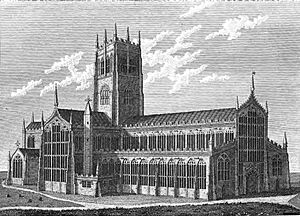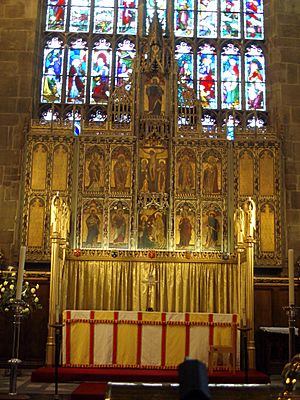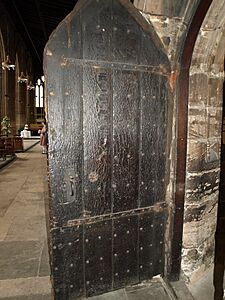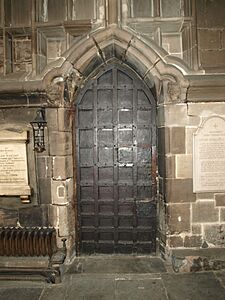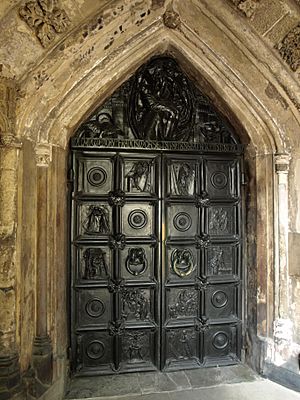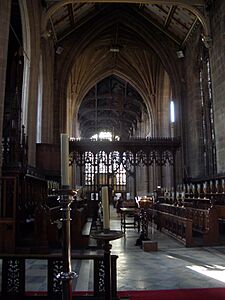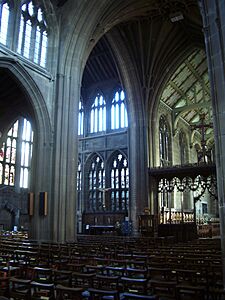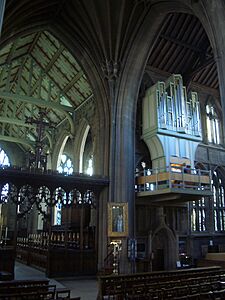St Mary's Church, Nottingham facts for kids
Quick facts for kids St Mary's Church |
|
|---|---|

St Mary's Church and the County War Memorial
|
|
| Lua error in Module:Location_map at line 420: attempt to index field 'wikibase' (a nil value). | |
| Country | England |
| Denomination | Church of England |
| Churchmanship | Book of Common Prayer / Broad Church |
| Website | www.stmarysnottingham.org |
| History | |
| Dedication | St Mary the Virgin |
| Architecture | |
| Heritage designation | |
|
Listed Building – Grade I
|
|
| Designated: | 11 August 1952 |
| Reference #: | 1342118 |
| Administration | |
| Diocese | Southwell and Nottingham |
| Province | York |
The Church of St Mary the Virgin is the oldest church in Nottingham, England. It's a very important building, listed as 'Grade I' because of its amazing history and architecture. Only five buildings in Nottingham have this special listing!
You can find St Mary's on High Pavement, right in the middle of the old Lace Market area. That's why it's also known as St Mary's in the Lace Market. It's part of a group called the Major Churches Network.
Contents
A Look Back: St Mary's Church History
St Mary's Church is mentioned in the Domesday Book from 1086. This means it has been around since Saxon times! The church you see today is at least the third one built on this spot. Most of the current building was constructed between 1377 and 1509.
The main part of the church, called the nave, was finished before 1475. It's famous for its consistent Perpendicular Gothic style. The south aisle wall was likely built first, around the 1380s. The rest of the nave and transepts followed in the early 1400s. The tower was completed during the time of Henry VIII.
From 1108 to 1538, Lenton Priory owned the church. The monks acted as the church's rectors. They hired a vicar to lead the daily services.
In 1513, a school called The Free School of the Town of Nottingham started in the church. Dame Agnes Mellers founded it. This school is now known as Nottingham High School. Every year, a special service is held at the church to remember its founding. This event is one of the oldest traditions in Nottingham.
George Fox, who started the Quakers, was put in prison in Nottingham in 1649. This happened after he interrupted a preacher at St Mary's.
The Nottingham Bluecoat School began in 1706. Its first lessons were taught right in the church's porch!
For several years starting in 1716, the church was used to store the town's fire engine. It was kept at the west end until at least 1770.
St Mary's also opened a workhouse in 1726. It was located on Mansfield Road. The church ran it until 1834. The workhouse was later torn down in 1895. This made space for the Nottingham Victoria railway station.
The church closed for five years starting in 1843 for a big Victorian restoration. It reopened on May 19, 1848. The Bishop of Lincoln, John Kaye, led the reopening service.
The First Sunday School
St Mary's was a pioneer in Sunday school education. It offered classes for children who couldn't go to school during the week. Students learned reading, writing, and math, along with religious lessons. The very first Sunday School opened here in 1751. This was 35 years before the more famous Sunday School started by Robert Raikes in Gloucester.
New Churches Started from St Mary's
Over the years, St Mary's was so important that many new churches were created from its parish. This helped serve the growing population of Nottingham. Some of these churches include:
- 1822: St Paul's Church, George Street, Nottingham
- 1841: Holy Trinity Church, Trinity Square
- 1844: St John the Baptist's Church, Leenside, Nottingham (destroyed in 1941)
- 1856: St Mark's Church, Nottingham
- 1856: St Matthew's Church, Talbot Street
- 1863: St Ann's Church, Nottingham
- 1863: St Luke's Church, Nottingham
- 1863: St Saviour's in the Meadows
- 1864: All Saints' Church, Nottingham
- 1881: Emmanuel Church, Nottingham
- 1888: St Catharine's Church, Nottingham
- 1903: St Bartholomew's Church, Nottingham
Church Restorations and Updates
St Mary's has been repaired and updated many times over the centuries:
- 1762: The west front was rebuilt in a Classical style.
- 1818–20: The south aisle was restored.
- 1843: The tower was saved from falling down.
- 1844–1848: A major five-year restoration of the roofs and west front took place. The church was closed during this time.
- 1848–1860s: More internal restoration work was done.
- 1872: The chancel roof was replaced.
- 1890: The Chapter House was built.
- 1912: The Lady Chapel was added.
- 1935: The tower's ringing room floor was concreted.
- 1940: The Simpson memorial choir vestry was added.
- 1992–93: The outside of the church was restored and cleaned.
- 2008: New kitchens and toilets were added.
- 2013: Wooden floors were removed, and new stone floors with underfloor heating were installed.
- 2024: The South Transept was repaired.
The Ancient Chantry Door
The chantry door is thought to be the oldest door still existing in Nottingham. It dates back to the 1370s or 1380s. It has an example of medieval ironwork in its locking system.
The chantry room has been used for many things over time. It was a bone storage room, a coal store, and a place to keep chairs. Now, it has a toilet for wheelchair users.
This old door probably survived because it hasn't been used much. Also, it's inside the church, which protected it.
Laying on of Hands Tradition
Around 1760, a special practice called "laying on of hands" during a confirmation service was first seen and written about at St Mary's. This was done by John Gilbert, who was the Archbishop of York.
Special Features of St Mary's
Beautiful Bronze Doors
The amazing bronze doors were designed in 1904 by Henry Wilson. They were made to remember his father-in-law, Rev. Francis Morse.
The doors tell the story of Jesus's life and his connection to the Virgin Mary, to whom the church is dedicated. They also show the idea of pity.
Above the doors, a figure of the Holy Mother holds the body of Christ. On either side, there are images suggesting the gates of Death and Life. A dove, representing the spirit, flies into one gate and out the other. This symbolizes the never-ending cycle of death and life.
The doors themselves have ten panels made of beaten bronze. Each panel shows a scene from the New Testament. On the left door, you can see:
- "The Annunciation": Gabriel appearing to the Virgin Mary.
- "The Visitation": Mary meeting her relative.
- "The Nativity": The birth of Jesus.
- "The Epiphany": The wise men visiting Jesus.
- The "Salvator Mundi" (Savior of the World) on a vine cross. Adam and Eve stand at the bottom, and doves of peace fly above.
On the right door, the panels show:
- "The flight into Egypt"
- "The Baptism in the Jordan"
- "The entry into Jerusalem"
- "The three Maries at the Sepulchre"
- "The Resurrection": Jesus rising from the tomb. A dove flies to his chest, and birds sing for a new dawn.
Other Interesting Features
The church has a wonderful collection of stained glass windows from the late Victorian era. Many famous artists like Kempe and Hardman & Co. made them. The screen behind the altar, called a reredos, was created by Charles Edgar Buckeridge.
You can also see an old octagonal font. It has a special Greek message that reads the same forwards and backwards: ΝΙΨΟΝΑΝΟΜΗΜΑΤΑΜΗΜΟΝΑΝΟΨΙΝ (Wash my transgressions, not only my face). There's also a damaged alabaster tomb piece. It shows a lily crucifix and a panel of Archbishop Thomas Becket.
St Mary's Church Today
St Mary's is a very large church:
- It is about 215 feet (66 m) long from west to east.
- It is about 100 feet (30 m) wide across the transepts.
- The tower stands 126 feet (38 m) tall.
The church serves many different groups of people. It is the official Civic Church for the City of Nottingham. In the past, the town mayor was even elected here!
It is also the University Church for the University of Nottingham. Many schools and organizations hold their yearly services at St Mary's.
Besides being a place of worship, St Mary's often hosts concerts and public performances.
The assistant curate at St Mary's holds an old title: 'Lecturer'. This title was brought back in 1975 for Rev. John Pennington. The current Lecturer is The Rev'd Philippa Scott, who started in 2024.
The church uses traditional liturgical colours for its services. The main services feature a robed choir. Services follow both the Book of Common Prayer and Common Worship.
Sometimes, St Mary's still celebrates the Eucharist in an old way. The priest and people face east towards the High Altar. This is different from the more common modern practice where the priest faces the congregation.
The Vicarage: A Home for the Vicar
The vicarage (the vicar's home) for St Mary's used to be at Washington House on High Pavement. But as the Lace Market became more industrial in the late 1800s, the church bought a new home. This new vicarage was opposite the castle gatehouse. It was used until Canon Eddie Neale retired in 2003.
The house next door used to be the rectory for St Peter's Church, Nottingham.
Now, a new parish house has been bought in The Park Estate.
Important People Buried at St Mary's
Many notable people have been buried at St Mary's Church, including:
- John Samon, Mayor of Nottingham, 1416
- Thomas Thurland, Mayor of Nottingham, 1473
- John Holles, 1st Earl of Clare, 1637
- John Holles, 2nd Earl of Clare, 1666
- Eleanor Fitzwilliam, Countess of Tyrconnell, 1681
- Lady Jane, Dowager Countess of Valentia, 1683/4
- Chambre Brabazon, 5th Earl of Meath, 1715
- Lady Mary Brabazon, 1737
- Thomas Berdmore, dentist to King George III, 1785
- George Africanus, 1834
- Robert Aldridge, Vicar of St Mary's (1598–1616)
Notable Marriages at the Church
Some important marriages have also taken place here:
- George James Bruere, who later became Governor of Bermuda, in 1743.
- Alexander Manson MD, a doctor famous for using iodine in medicine, in 1814.
Bells and Clock
The church has twelve bells that can be rung.
|
|
The first record of a clock in the tower is from 1707. It was installed by Richard Roe. This clock was replaced in 1807 by a new one. The 1707 clock was then moved to Staunton church.
The most recent tower clock was put in place in 1936. It was made by G. & F. Cope and was the first electric auto-wind clock by that company.
In May 2022, it was discovered that the bell tower walls needed repairs. The swinging of the bells was putting too much stress on the wooden supports. Because of this, regular bell ringing stopped. The repairs were expected to cost a lot of money. By April 2023, the cost had risen, but enough money was raised. The bells were expected to ring specially for the coronation of King Charles III, even with scaffolding supporting the walls.
Music at St Mary's
The Choir
The choir at St Mary's sings for three services each week. These are Wednesday Evensong, Sunday Eucharist, and Sunday Evensong. The choir is led by John Keys and is very well-regarded. They are known for singing many different types of music, from old plainsong to brand new pieces. They also perform concerts, sometimes with the church's own orchestra, The Orchestra of the Restoration. Students in higher education can even get scholarships to join the choir or play the organ.
The Organ
The church's organ was built by Marcussen & Søn from Denmark. It was installed in 1973. It's a great example of a neo-classical style instrument. Even though it's a smaller organ for a church of this size, it's very high quality. It helps support the choir and congregation during services. It's also used for solo performances.
Images for kids


